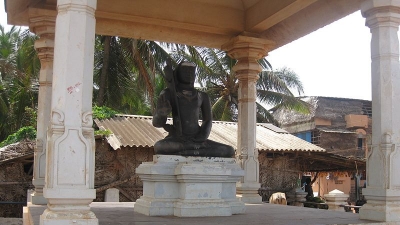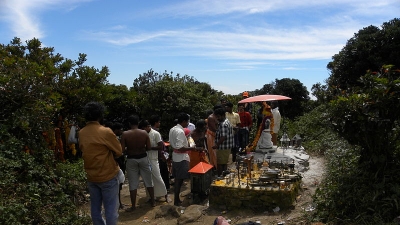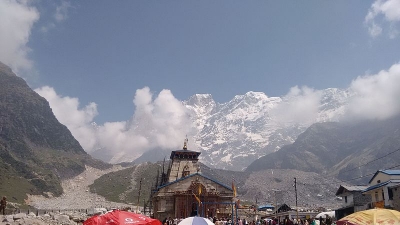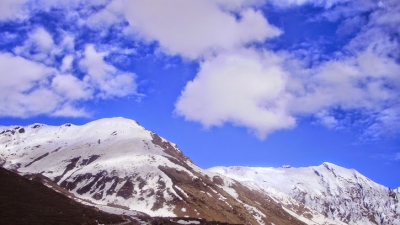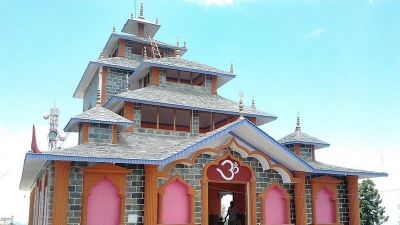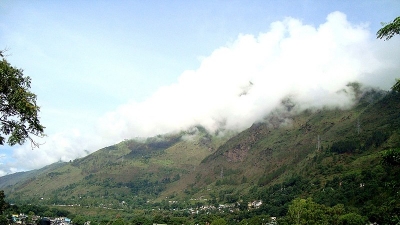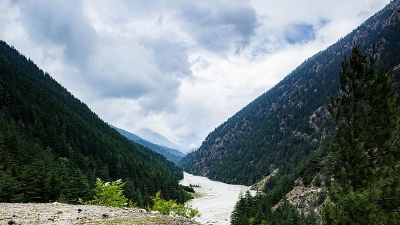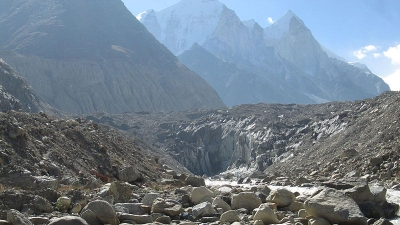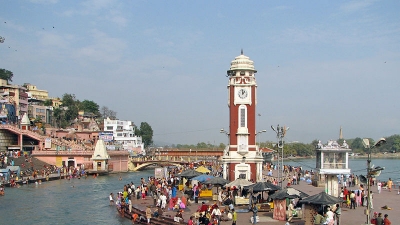Kedarnath Attractions - Tourist Places To Visit In Kedarnath
-
01Kedarnath Temple
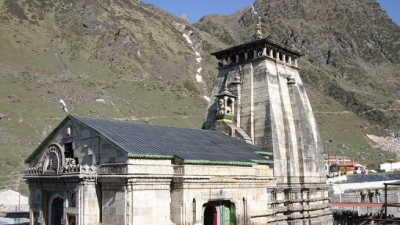 + Read More
+ Read MoreKedarnath Temple, located amidst the Kedarnath Mountain Range, is a prominent pilgrimage centre, where the Jyotirlinga of Hindu Lord Shiva is enshrined. This Jyotirlinga of Kedarnath, located at an altitude of 3584 m is the most significant of all the 12 Jyotirlingas. River Mandakini flows close by this 8th century AD temple, which was founded by Adi Shankaracharya. This temple is adjacent to an old temple, which according to legend was built by the Pandavas. One can see figures of various Hindu Gods and Goddesses in the inner walls of the assembly hall.
A statue of Nandi Bull, who according to mythological stories is the mount of Lord Shiva, is placed outside the temple as a guard. The temple which dates back to more than 1000 years was built using uniformly cut heavy stone slabs on a rectangular platform. There is a ‘Garbha Griha’ in the temple where devotees worship the Lord. In addition, one can also find a mandap in the temple premises, where various religious ceremonies are held. According to folklore, after the fight of Kurukshetra was over, the Pandavas came to this temple to repent for their sins.
-
02Gaurikund
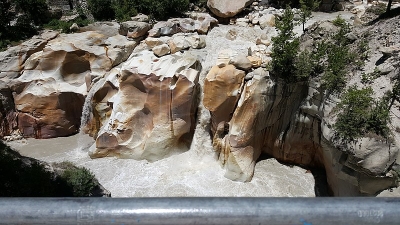 + Read More
+ Read MoreGaurikund is a small village, which serves as the trekking base for Kedarnath. The place, which is situated at an altitude of 1982 m, has an age-old temple devoted to the Hindu deity, Parvati. It is believed that this is the same place where Goddess Parvati meditated to win the heart of the Hindu Lord Shiva. There is a hot-water spring called Gaurikund located in the region, the water of which has medicinal value and it is also known to wash off the sins of the devotees.
-
03Vasuki Tal
+ Read MoreVasuki Tal is situated at an altitude of 4135 m above sea level and is about 8 km away from Kedarnath. The lake, situated amidst magnificent Himalayan Ranges, is considered to be one of the prominent tourist destinations of Uttarakhand.
Travellers visiting this place can also enjoy the beauty of the Chaukhamba peaks, which are situated in the vicinity of this lake. Travellers have to pass over the glaciers of Chaturangi and Vasuki to reach this place. Crossing these glaciers is a difficult task and requires a lot of strength and stamina.
Tourists are advised to visit this place between the months of June and October, as during these months, the temperature of the place is quite pleasant.
-
04Sonprayag
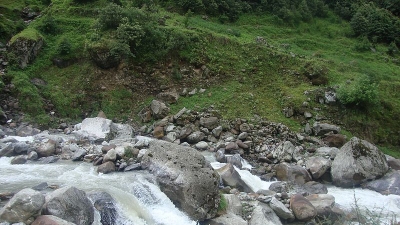 + Read More
+ Read MoreSonprayag is situated at an elevation of about 1829 m, at a distance of 19 km from Kedarnath. This is the place where two of the rivers, namely, Basuki and Mandakini, converge. This place, which is located on the Kedarnath route, holds immense religious significance, owing to the sacred water of the river. According to the legends, mere touch of the water of Sonprayag is a step forward towards the Baikunth Dham.
-
05Chorabhari Tal
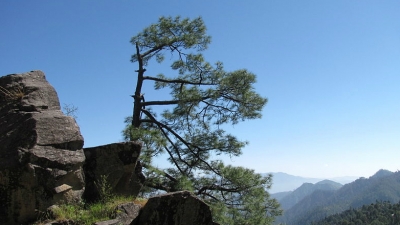 + Read More
+ Read MoreChorabhari Tal is situated at an altitude of 3900 m above sea level, close to the mouth of the Chorabhari Bamak glacier. The place, which is located on the foot of the Kedarnath and Kirthi Stambh peak, offers magnificent views of the Himalayan Peaks.
This tal is also known by the name Gandhi Sarovar after Mahatma Gandhi’s ashes were immersed in the lake. According to legends, this is the same lake from where Yudhishthira, the eldest of the Padavas, departed for paradise. This place can be reached by trekking 3 km.
The iron bridge of Kedarnath, directly leads to the Gandhi Sarovar, half of the route of which is nicely paved for the travellers. On the way, visitors can see a beautiful waterfall. Moreover, it is recommended that one should visit this place early in the morning, owing to the changing weather conditions of the place.
-
06Shankaracharya Samadhi
+ Read MoreShankaracharya Samadhi or the grave of Adi Guru Shankaracharya is situated in proximity to the Kedarnath Temple. Sri Shankaracharya was a noted Hindu Sage, who travelled far and wide to spread the knowledge of Advaita Vedanta. It is also believed that it was he who remodelled the Kedarnath Temple in the 8th century and also established four Mathas. According to legends, he started his journey from Jyotirmath Ashram of Badrinath and travelled to the mountains of Kedarnath, which became his final resting place. Four of the most loved disciples of Shankaracharya followed him but he insisted upon them to leave and continued the journey alone.
Travellers can also find a hot water spring in the region, which was supposedly created by Shankaracharya to wear off the pain of his disciples who were suffering from the adversities of the climate. According to a folklore, Shankaracharya took his Samadhi at an early age of 32 years after finding the Char Dhams, the pilgrimage spots of the Hindus.
-
07Agastyamuni
+ Read MoreAgastyamuni is situated at an altitude of 1000 m, on the banks of the River Mandakini. This place had been the abode of the famous Hindu Sage Agastya Rishi, who meditated here for years. The temple is also called Agasteshwar Mahadev temple by the locals. Visitors can find images of the renowned Hindu deities carved on the stone walls of the temple. A large number of tourists visit this place to attend the various fairs organised in the temple. The festival of Baisakhi is celebrated with much enthusiasm, and during this time, the temple is flocked by devotees from far and wide.
Tourists interested in fishing can do so in the River Mandakini, which is situated in proximity to the temple. This place also serves as a base for Pawan Hans Helicopter Services, which are available till Kedarnath temple. Food and lodging facilities are available for tourists in the nearby private hotels and forest guest houses.
-
08Bhairav Nath Temple
+ Read MoreBhairav Nath Temple is situated at a distance of 0.5 km from Kedarnath Temple. The temple is devoted to the Hindu deity Lord Bhairav, who is supposedly the main gana of Shiva, the Hindu God of Destruction. The first Rawal or Rajput, Sh. Bhikund, established the idol of the deity in the temple in 3001 B.C. The deity of the temple is also known as Kshetrapal or the guardian of the region. According to the legends, when Kedarnath Temple closes during winters, Bhairavnath guards the complex of the temple.
-
09Mandakini River
 + Read More
+ Read MoreMandakini River, a tributary of the River Alaknanda originates from the Charabari glacier. The river, after being fed by the River Vasukiganga at Sonprayag, meets River Alaknanda at Rudraprayag, and finally merges into Bhagirathi in Devprayag to form the holy River Ganga.
River Mandakini has more of class 3 rapids and a few class 4 and 5 rapids, which make it ideal for kayaking and rafting. Moreover, there is a small bridge situated behind Kedarnath Temple, which can be used for crossing the river.
-
10Trekking
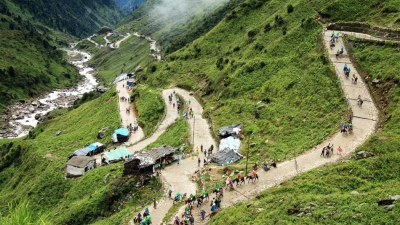 + Read More
+ Read MoreKedarnath provides ample trekking opportunities to the tourists. The temple is not directly connected to any motorable road, so travellers can either avail helicopter services or trek for 14 km from Gaurikund to reach the destination. The most popular trekking route, which starts from Kedarnath, traverses along the River Bhagirathi, and then goes through dense forests till Lata.
Trekkers usually go from Lata to Gangotri by road in 5 hours, and again from Gangotri, the next part of the trek starts, which goes along the Gangotri Glacier and finally leads to the beautiful lush green meadows of Tapovan. Kedarnath to Vasuki Tal is an enjoyable trek too, and allows the travellers to enjoy the beauty of the Mandakini Valley and the Chaukhamba Peaks.
-
11Rambara
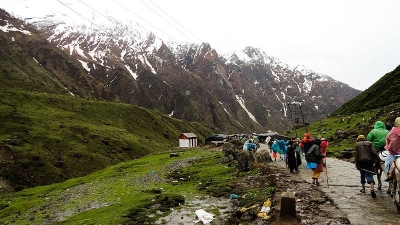 + Read More
+ Read MoreRambara is a prominent village, which serves as a resting place for the devotees going to Kedarnath. The hamlet, which is perched at an altitude of 2591 m lies halfway on the 14-km-long trek to Kedarnath. Gaurikund is located at a distance of 7 km from this place and Kedarnath is 7 km away from Gaurikund. Travellers can avail accommodation facilities in the GMVN Tourist Rest House.
-
12Kedarnath Mountain
+ Read MoreKedarnath Mountain is situated in the western Garhwal Himalayas. There are two mountains namely Kedarnath and Kedarnath dome, of which Kedarnath dome is the subpeak, located 2 km north-west of the main peak. These two peaks are counted amongst the top three peaks of the southern side of the Gangotri glacier. Moreover, the north-west region of the Kedarnath Dome has skiing slopes, which are popular among the adventure enthusiasts.
-
13Kedar Massif
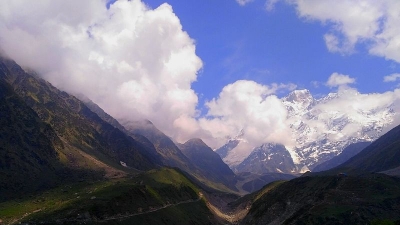 + Read More
+ Read MoreKedar Massif is formed by three mountains namely Kedarnath, Kedar dome and Bharatekuntha. It is situated at an altitude of 6000 m and is the point from where many glaciers flow, including Mandakini. The mountains of Kedarnath and Kedardome are linked to each other by furrows.
The Kedarnath Mountain perched at an altitude of 6831 m is very difficult to hike and Kedarnath dome is challenging too. The amount of oxygen in the air is less here, owing to extremely high altitude. Trekkers are advised to take the route from behind the Kedarnath Temple to Bharatekuntha. Chorabhari Tal, which is located 3 km away in the valley formed by the Kedarnath Massif.



 Click it and Unblock the Notifications
Click it and Unblock the Notifications

